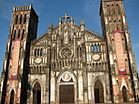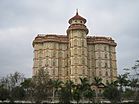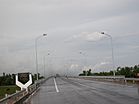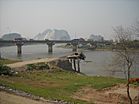Hà Nam province facts for kids
Quick facts for kids
Hà Nam province
Tỉnh Hà Nam
|
|
|---|---|
|
Phủ Lý City • Bà Đanh Temple • Sở Kiện Cathedral • Hà Hoa Tiên University • Đáy River • Yên Lệnh Bridge • Đoan Vỹ Bridge
|
|
| Nickname(s):
South of the river
|
|
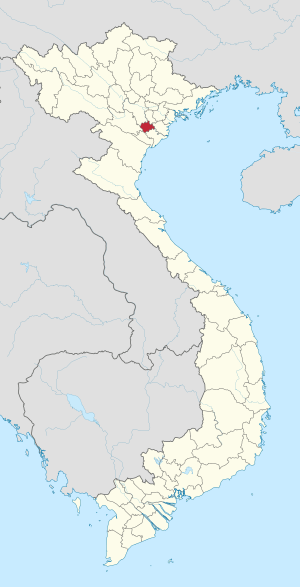
Location of Hà Nam within Vietnam
|
|
| Country | |
| Region | Red River Delta |
| Capital | Phủ Lý |
| Area | |
| • Total | 862.0 km2 (332.8 sq mi) |
| Population
(2021)
|
|
| • Total | 920,623 |
| • Density | 1,068.01/km2 (2,766.13/sq mi) |
| Demographics | |
| • Ethnicities | Vietnamese, Tày, Mường, Hoa |
| Time zone | UTC+7 (ICT) |
| Area codes | 226 |
| ISO 3166 code | VN-63 |
Hà Nam is a province in northern Vietnam. It's located in the Red River Delta region. The name "Hà Nam" means "south of the river" in Vietnamese. This province has a rich history and has seen many changes over the years.
Contents
History of Hà Nam Province
Hà Nam, like all of Vietnam, worked on special plans to improve the country. From 1975 to 1980, they focused on protecting their borders. They also worked to solve problems within the country. Between 1981 and 1985, the government tried to make life better for everyone. They wanted to improve society and culture.
These years were tough for Vietnam and Hà Nam province. The economy faced many problems. Most people had a very low standard of living. But even with these challenges, Hà Nam still made important progress.
In February 1979, the Sino-Vietnamese War started. This war directly affected Hà Nam province. People in Hà Nam helped by joining the military. Local forces also helped with national defense plans.
In the early 1980s, Vietnam started a new plan. This was due to changes happening around the world. People and different industries faced difficulties. It was hard to get raw materials and food. The economy was unstable, leading to high prices.
A special rule, Decree 100/CT/TW, was released in 1981. This rule helped boost farming and production. It helped the nation get its agriculture problems under control. From 1981 to 1985, Hà Nam used its land better. Food production kept growing during this time.
Industries and small craft businesses created many jobs. Local areas also started exporting goods. These included items like jute, groundnuts, garlic, and sesame. Education standards were kept high and improved. Traditional and modern medicine worked together. The media helped share new information and support the province's goals.
How Hà Nam is Organized
Hà Nam province is divided into six main areas. These are like districts:
- 4 districts:
- Bình Lục
- Kim Bảng
- Lý Nhân
- Thanh Liêm
- 1 provincial city:
- Phủ Lý
- 1 town:
- Duy Tiên
These areas are then split into smaller parts. There are seven small towns, 98 communes (like villages), and 11 wards (parts of a city).
Farming and Industry Growth
Hà Nam province worked hard to improve its farming. They built a large irrigation system. This helped water crops and made more land good for farming. They also improved how cattle were raised. New scientific methods were used to help crops grow better.
By 1987, many farms in the province were producing a lot of food. They reached five tons of crops per hectare. Farming areas also provided thousands of tons of food for the state.
Handicraft industries also grew. They made more products, and the quality got better. Basic education improved quickly and fairly for everyone. Information, culture, health, and sports activities became stronger at the local level.
In 1986, Vietnam started a big change called the "renovation process." This removed old rules that held back the economy. It made it easier for different types of businesses to grow. The economy focused on four main programs. Social, cultural, scientific, and medical activities also became stronger.
Farming grew a lot. Private businesses also developed, giving jobs to many people. Banking and financial services became important parts of society.
By late 1996, Hà Nam's farms produced a total value of VND960.84 billion. Food production reached 319,435 tons. Each person had about 402 kg of food. Besides rice, crops like maize, groundnuts, and peanuts also grew well. The number of cattle and poultry increased by 3-5% each year.
Water areas were used to grow aquatic products. Thousands of bamboo trees were planted to protect river banks. Lots of land was dug, covered, and cleared. Thousands of stones were used to build channels.
Local Crafts and Businesses
In the early 1990s, local industries and small handicraft businesses kept developing. Even with challenges in getting materials, some products continued to be made. These included Thanh Hà embroidery and Kiện Khê stone products. Other crafts were An Đổ smoothing, Động Sơn knitting, and Đại Thành weaving.
In 1996, the value of industrial production was VND286.75 billion. A private business with nine locations was set up. It created jobs for almost 400 workers.
See also




